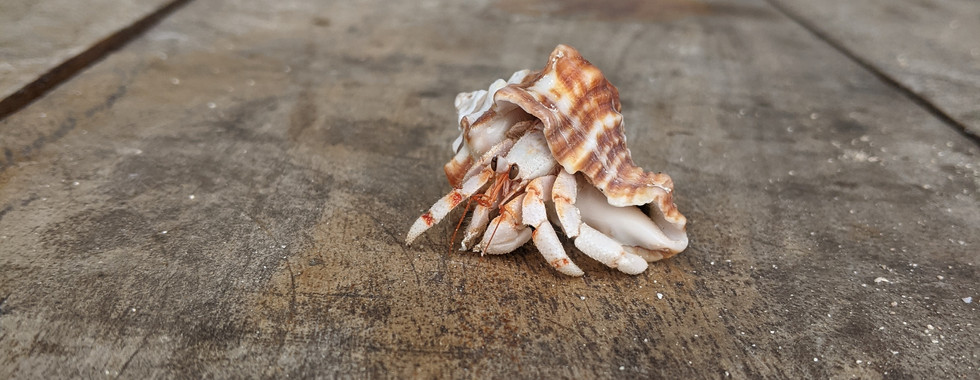Telos Vivaria: A Hermit Crab Setup
- telos-exotics
- Feb 24, 2023
- 2 min read
Overlooked as "basic" pets, land hermit crabs are delightful, complex creatures that deserve the opportunity to express their telos. Taking the time to consider their biology and natural habitat means a more engaging and fulfilling experience of caring for the crabs and their tropical paradise enclosure, too!
The Species: Coenobita sp. - Land Hermit Crabs

Hermit crabs are extremely common pets, yet their natural behaviors and lifestyle are often ignored when it comes to their care and husbandry. Because they are small and can survive a wide range of conditions, they are frequently kept in small enclosures without enough humidity, space to burrow, or access to both fresh and saltwater.
In the wild, a hermit crab has the opportunity to move around and place themselves in areas that meet their current needs: more or less humidity, higher or lower temperatures, more or less salt, crawling around on the ground surface or burrowing deep underneath, etc. It can be overwhelming to try to recreate so many gradients in an enclosure, but it isn't as hard as it sounds! For our setup, we decided to try to replicate a miniaturized shoreline.

Our Husbandry Goals:
In order to support the welfare of our hermit crab inhabitants, our goal is to provide an excellent setup that allows for:
Osmoregulation via salt water and fresh water
Maintaining high humidity across the enclosure
The ability to shed safely in substrate burrows
The ability to thermoregulate across a temperature gradient
Dietary diversity for health and enrichment
Access to fresh shells as they grow
Hermit Crab Natural Habitat:
Climate: Hermit crabs live on tropical coasts all over the world. Though there can be some seasonality with changes in ambient/sea temperature or frequency of storms, generally it's warm, humid, and salty year-round. I imagine if I were a hermit crab, the most relevant seasonal changes would be variations in sea temperature and food options - perhaps certain seasons see more or less of certain food items washing up on shore.
The two example locations below are both places we've traveled and observed Coenobita hermit crabs living their best lives in the wild. Daylight averages nicely at 12hr/day, and expect nearly every day to hit a high of 85* at least.
Example Locations: *source: weather-and-climate.com, timeanddate.com
(by monthly average) | Pago Bay, Guam | Pingwe, Zanzibar, Tanzania |
Avg high temps | 85-88*F | 84-91*F |
Avg low temps | 75-78* | 65-75*F |
Avg humidity | - | 75-83% |
Avg hours of daylight | 11.2-12.5hr/day | 11.5-12.3hr/day |
Typical Vegetation: Lots of tropical plants, particularly salt-tolerant ones that grow well along the coast. There are usually large trees and palms dropping leaf litter, along with lots of shrubs, "weeds," etc. Mangroves are common in these areas. In addition to the terrestrial vegetation, lots of plant matter will wash up on the beach like different kinds of seaweed.
Other animals around: This is a short list of some of the frequently observed species we've also spotted in this habitat. A bit further up the beach, they live among ants, skinks, geckos, wolf spiders, isopods, etc. On the beach and in the water, they live among snails, other types of crabs, amphipods, sea cucumbers, shrimp, anemones, starfish, and lots of types of fish
Here are some habitat inspiration photos from our past travels to Guam, Palau, and Zanzibar (Tanzania).
The Setup:
[photos to come]
Enclosure
Glass aquarium - we're using a 40 gallon long tank measuring 48 x 12 x 16".
Substrate & Drainage Layer
No drainage layer since this is a pseudo-paludarium-type setup. The "marine" portion of the tank mimics a beach with tidepools. We added a vertical barrier 1/4 of the way down the tank to limit the saltwater to that area. The middle section is a transition area from the beach inland. This area is a combination of sand and coco fiber. The inland section substrate is a combination of coco chips, coco fiber, sand, leaf litter, and crushed charcoal.
Cleanup Crew (CUC)
Beach cleanup crews are super cool. The best part here is that the hermit crabs are part of the CUC already. But some additional options are coastal amphipods, isopods, and snails. Crickets are also common beach scavengers and harmless to the crabs.
Structures
Rocks and coral, branches, coconut husks. Freshwater pond is [volume], with a "rock wall" to climb in and out.
Plants
We've reviewed different types of plants that we've seen thriving along beaches, and chose a few as a starting point to see what will thrive in our little slice of tropical paradise. Some of the options we're trying out are palms, ferns, mosses, commelinas, pileas, sea grape, sensitive plants, and malabar spinach.
Lighting, Temperature, and Humidity Control
Our goal is to balance a 12hr/12hr day/night cycle with maintaining 70%+ ambient humidity, with a temperature gradient achieved through a back heat mat (making a "warm substrate" area) as well as overhead lighting. We have a UVB light bar along the top of the enclosure, a basking lamp over the "beach transition" area, and an additional plant light over the "inland" area. Humidity is kept high from the water sources in the enclosure, and glass/acrylic panels on the lid to minimize humidity escaping. This decrease in airflow means that during setup, we needed to carefully confirm that none of our heat/light fixtures would build up too much heat.
Feeding: I've found this page to be a great reference for HC diet! Hermit Crab Food Guide - Crab Street Journal
[build photos to come!]



















Comments